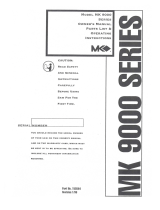
PAGE10 — SP7060 PAVEMENT SAW • OPERATION MANUAL — REV. #0 (02/13/09)
RULES AND REGULATIONS
Whenever necessary, replace nameplate, operation and
safety decals when they become difficult to read.
ALWAYS check the equipment for loosened
threads or bolts before starting.
NEVER touch the hot exhaust manifold,
muffler or cylinder. Allow these parts to cool
before servicing engine or pump.
ALWAYS allow the engine to cool before adding fuel or
performing service and maintenance functions. Contact
with
hot
components can cause serious burns.
NEVER operate this equipment in any enclosed or narrow
area where free flow of the air is restricted. The engine of
this equipment requires an
adequate free flow of cooling
air. If the air flow is restricted it
will cause serious damage to
the equipment or engine and
may cause injury to people and
property. Remember the
engine gives off DEADLY
gases.
ALWAYS refuel in a well-ventilated area, away from
sparks and open flames.
ALWAYS use extreme caution when working with
flammable liquids. When refueling, stop the engine and
allow it to cool.
DO NOT smoke around or near the
equipment. Fire or explosion could result
from fuel vapors, or if fuel is spilled on a
hot engine.
NEVER operate the equipment in an
explosive atmosphere or near combustible
materials. An explosion or fire could result
causing severe
bodily harm or even
death.
AVOID wearing jewelry or loose fitting clothing that may
snag on the controls or moving parts. This can cause
serious injury.
Make certain the operator knows how to and is capable
of turning the engine OFF in case of an emergency.
DO NOT top-off fuel tank. Topping-off is dangerous as it
causes fuel to spill.
GENERAL SAFETY
DO NOT operate or service this equipment
before reading this entire manual.
This equipment should not be operated by
persons under 18 years of age.
NEVER operate this equipment without proper protective
clothing, shatterproof glasses, steel-toed boots and other
protective devices required by the job.
NEVER operate this equipment when not
feeling well due to fatigue, illness or when
under medication.
NEVER operate this equipment under the
influence of drugs or alcohol.
NEVER disconnect any
“emergency or safety devices.”
These devices are intended for operator safety.
Disconnection of these devices can cause severe injury,
bodily harm or even death! Disconnection of any of these
devices will void all warranties.
NEVER use accessories or attachments that are not
recommended by Multiquip for this equipment. Damage
to the equipment and/or injury to user may result.
Manufacturer does not assume responsibility for any
accident due to equipment modifications. Unauthorized
equipment modification will void all warranties. Any
modification which could lead to a change in the original
characteristics of the machine should be made only by
the manufacturer who shall confirm that the machine is
in conformity with appropriate safety regulations.
WARNING — Read This Manual
Failure to follow instructions in this manual may lead to
serious injury or even
DEATH!
This equipment is to be
operated by trained and qualified personnel only! This
equipment is for industrial use only.





























